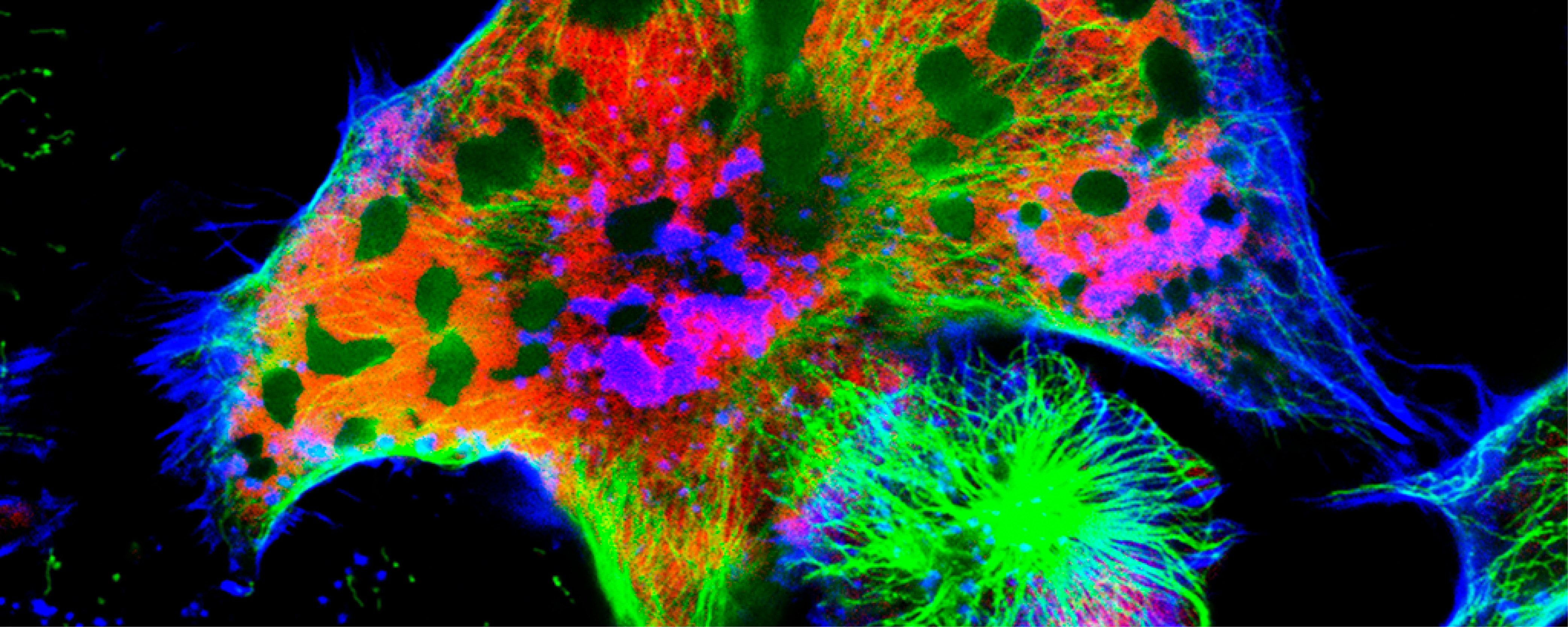
What is cancer?
What is cancer?
In patients with cancer, cells grow in an abnormal way and multiply uncontrollably, invading healthy tissue.
The body has natural systems to prevent the growth of cancerous cells by either repairing the damage to the DNA or forcing the cell to die, if the damage is too great. Cancer occurs when these inbuilt defence mechanisms fail.
The term cancer, describes a group of diseases that share this characteristic. Cancers are usually classified according to the location in the body where the abnormal cell growth began. There are more than 200 different types of cancer.
Cancerous cells can grow abnormally in blood or form masses called tumours. Some tumours are benign – meaning they can’t spread and therefore aren’t cancerous.
Malignant tumours, which are cancerous, are collections of abnormal cells that do spread and invade healthy tissue. Any cancer can interfere with the way the body functions, eventually becoming life-threatening.
How does cancer start?
Cancer starts when healthy cells begin to grow abnormally. Typically, cells grow, divide and die in a normal way. In people with cancer, cells don’t follow this process – instead, they grow when they aren’t needed, remain when they should have died and divide without stopping.
These abnormal cells can remain localised or spread throughout the body and invade other healthy tissues and organs.
How does cancer spread?
The location in the body where cancer begins is called the primary site. Cancerous cells can multiply in the primary site, or spread by breaking away from it.
When they break away, cancerous cells travel through the bloodstream or the lymphatic system to another part of the body, where they start multiplying again. This process is known as metastasis.
Cancer that forms as a result of spreading from the primary site is referred to as metastatic or secondary cancer.
What causes cancer?
Cancer’s pattern of abnormal cell growth is genetic, and it is caused by changes to the genes that control cell function or mutations to the DNA that make up the genes that control cell function.
Cancer-causing genes can be inherited from family members. They can also develop in the body as a result of lifestyle choices and environmental exposures that damage DNA.
What different types of cancer exists?
Cancerous cells can develop in the skin or tissues covering internal organs (carcinoma), in connective tissues (sarcoma), in the blood-forming tissue (leukaemia), in the immune system (lymphoma and multiple myeloma) and in the brain or spinal cord (central nervous system).
Generally, cancer is classified depending on the organ the abnormal cell growth begins in. For example, cancer that begins in the breast is called breast cancer.
What are signs and symptoms?
Signs and symptoms can help doctors diagnose certain types of diseases.
A sign is a presentation that can be noticed – for example, an irregular heartbeat which can be detected with a stethoscope, or a lump in the breast which can be discovered with a breast check.
A symptom, on the other hand, is a feeling described by individuals. Pain, tenderness, bloating and itchiness are all different types of symptoms.
What are cancer signs and symptoms?
Cancer, a group of diseases characterised by abnormal cell growth, can cause many different types of signs and symptoms.
As there are more than 200 forms of cancer, signs and symptoms vary depending on the location of the cancer, whether it has spread to other areas or metastised, and if the individual has any other health concerns.
Some cancers don’t produce any signs or symptoms until they have become quite large. By this time, it’s likely the cancer has reached an advanced stage and has spread to other areas in the body. For example, it’s common for people with early-stage pancreatic cancer and ovarian cancer to have no signs or symptoms.
Other cancers can display vague signs and symptoms that can easily be confused with other diseases. For example, signs and symptoms of stomach cancer can include bloating and abdominal discomfort – both of which are common in other, more minor, health concerns.
Many types of cancers cause signs and symptoms when abnormal cells grow into tumours that cause pressure on nearby organs, blood vessels and nerves. For example, tumours in the brain can cause severe headaches, memory loss and difficulty controlling movement.
What are the stages of cancer?
Cancer occurs when abnormal cells grow in an uncontrolled way. Stage 0 cancer is a non-invasive, non-life threatening cancer, in which cells grow into a tumour in the location where it started.
In Stage 1 cancer cells have gained the ability to spread outside the initial location and begin to invade the neighbouring tissue. The cancer remains a single tumour, growing partly in the tissue where it began and partly in connecting tissue. This is a significant step, which enables the cancer to spread and it can become life threatening.
Staging describes the size and severity of the cancer and helps to inform the diagnostic and treatment approach. It offers information on the prognosis of the cancer and helps doctors to evaluate whether a patient will benefit from any clinical trials of new cancer treatments.
The stage of the cancer is determined at the initial diagnosis. The stage does not change even if the cancer continues to grow and spread. Instead, new information gets added on to the initial staging description.
The staging information provided below refers to solid tumours and is consistent worldwide. That enables health care professionals and researchers to exchange information on best treatment options for various types of cancer and to compare results from different clinical trials. Cancers of the central nervous system (brain tumours), childhood cancers and blood cancers are classified according to other, more relevant staging systems.
Once the cancer cells have spread from the initial location to neighbouring tissue, it’s possible that the cells start spreading further. The most common way for cancerous cells to spread is through a lymph (or lymphatic) vessel.
Lymph vessels form the lymphatic system, similar to the cardiovascular system in the body. They carry fluid called lymph. Lymph is filtered in lymph nodes which are distributed widely around the body. The lymphatic system is a vital part of the immune system – the body’s own defence mechanism against any pathogens, and plays a crucial part in the body’s fight against cancer.
When spreading further, a cancer cell may get caught in a lymph node. Sometimes the lymph node gets rid of the cancerous cell and sometimes the cancer cell divides and forms a lump in the lymph node. It can then continue to multiply and grow in the node.
In Stages 2 and 3 the cancer has spread to the region around the original tumour but has not yet spread to other parts of the body. Cancer can also start in the lymph nodes (e.g. lymphoma), which will then be classified as the cancer’s primary location.
Stage 4 means that cancer cells have spread to other organs or parts of the body. When they break away from the initial location, cancerous cells travel through the bloodstream, or the lymphatic system, to another part of the body where they start multiplying again. This process is known as metastasis.
Cancer that forms as a result of spreading from the primary site is referred to as metastatic or secondary cancer.
Treating and preventing cancer
Smoking is one of the most well-established causes of cancer, and as many as one in every nine cancers are caused by smoking. Alcohol consumption, as well as lifestyle and environmental factors such as diet, radiation and chemical exposure, can also lead to cancer.
Some cancers are attributed to inherited genes, while others develop without specific causes. Approximately 40% of cancers are thought to occur due to genetics, and 60% are attributed to environmental or other factors.
Raising awareness of the well-established cancer risk factors, encouraging patients to learn about their family history, and referring at-risk patients for regular screening checks risk are all important preventative measures.
Cancer treatment can involve a combination of surgery, chemotherapy, radiation therapy and other forms of therapies such as immunotherapy.
Traditionally, the treatment approach depends on the type of cancer being treated, and secondary cancers are often treated in the same way as primary cancers since a specific mutation may respond to a particular treatment regime irrespective of location.
Cancerous tissue can continue to mutate after treatment and if a relapse occurs, a different type of treatment may be required.
An emerging body of research is indicating that knowing a tumour’s genomic profile could be more important for successful treatment than knowing its location or size. As each tumour’s genomic profile is unique, this approach is often referred to as personalised or precision medicine.
Recent advances in immunotherapy have shown promising results, and it’s likely that it will become a routine cancer treatment in the near future.
